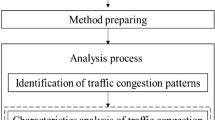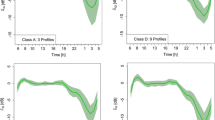Abstract
Nowadays, one of the main challenges faced in large metropolitan areas is traffic congestion. To address this problem, an adequate traffic control could produce many benefits, including reduced pollutant emissions and reduced travel times. If it were possible to characterize the state of traffic by predicting traffic conditions, measures could be taken to preventively mitigate the effects of congestion and related problems. This paper performs an experimental study of the traffic distribution in the city of Valencia, characterizing the different streets of the city in terms of vehicle load with respect to the travel time during rush hour traffic conditions. Experimental results based on realistic vehicular traffic traces show that most of the street segments under analysis present a good fit under quadratic regression, although a large number of street segments fall under other categories mainly due to lack of traffic. Based on this study, a clustering analysis study associated to the different streets shows how these streets can be classified into four independent categories, evidencing an uneven traffic distribution throughout the city.
Access this chapter
Tax calculation will be finalised at checkout
Purchases are for personal use only
Similar content being viewed by others
References
Jabali, O., Woensel, T., de Kok, A.G.: Analysis of travel times and \({\rm CO}_2\) emissions in time-dependent vehicle routing. Prod. Oper. Manag. 21(6), 1060–1074 (2012)
Djahel, S., Doolan, R., Muntean, G.M., Murphy, J.: A communications-oriented perspective on traffic management systems for smart cities: challenges and innovative approaches. IEEE Commun. Surv. Tutorials 17(1), 125–151 (2015)
Zambrano, J.L., Calafate, C.T., Soler, D., Cano, J.C., Manzoni, P.: Using real traffic data for ITS simulation: procedure and validation. In: 2016 International IEEE Conferences on Ubiquitous Intelligence and Computing, Advanced and Trusted Computing, Scalable Computing and Communications, Cloud and Big Data Computing, Internet of People, and Smart World Congress (UIC/ATC/ScalCom/CBDCom/IoP/SmartWorld), pp. 161–170. IEEE, July 2016. doi:10.1109/UIC-ATC-ScalCom-CBDCom-IoP-SmartWorld.2016.0045
Calafate, C.T., Soler, D., Cano, J.C., Manzoni, P.: Traffic management as a service: the traffic flow pattern classification problem. Math. Prob. Eng. (2015). Article ID 716598. doi:10.1155/2015/716598
Zhang, X., Onieva, E., Perallos, A., Osaba, E., Lee, V.: Hierarchical fuzzy rule-based system optimized with genetic algorithms for short term traffic congestion prediction. Transp. Res. Part C Emerg. Technol. 43, 127–142 (2014)
Onieva, E., Milanés, V., Villagra, J., Pérez, J., Godoy, J.: Genetic optimization of a vehicle fuzzy decision system for intersections. Expert Syst. Appl. 39(18), 13148–13157 (2012)
Hodge, V.J., Krishnan, R., Jackson, T., Austin, J., Polak, J.: Short-term traffic prediction using a binary neural network. In: 43rd Annual UTSG Conference, York, January 2011
Porikli, F., Li, X.: Traffic congestion estimation using HMM models without vehicle tracking. In: 2004 IEEE Intelligent Vehicles Symposium, pp. 188–193. IEEE, June 2004
Kunt, M.M., Aghayan, I., Noii, N.: Prediction for traffic accident severity: comparing the artificial neural network, genetic algorithm, combined genetic algorithm and pattern search methods. Transport 26(4), 353–366 (2011)
Sananmongkhonchai, S., Tangamchit, P., Pongpaibool, P.: Cell-based traffic estimation from multiple GPS-equipped cars. In: 2009 IEEE Region 10 Conference on TENCON 2009, pp. 1–6. IEEE, January 2009
Kerner, B.S., Rehborn, H., Aleksic, M., Haug, A.: Traffic prediction systems in vehicles. In: Proceedings of Intelligent Transportation Systems, 2005, pp. 72–77. IEEE, September 2005
Basnayake, C.: Automated traffic incident detection with GPS equipped probe vehicles. In: ION GNSS Proceedings of the 17th International Technical Meeting of the Satellite Division of the Institute of Navigation, pp. 1–10, September 2004
Behrisch, M., Bieker, L., Erdmann, J., Krajzewicz, D.: SUMO—Simulation of Urban Mobility: an overview. In: Proceedings of the Third International Conference on Advances in System Simulation, SIMUL 2011. ThinkMind (2011)
Nguyen, T.R.V., Krajzewicz, D., Fullerton, M., Nicolay, E.: DFROUTER—Estimation of vehicle routes from cross-section measurements. In: Behrisch, M., Weber, M. (eds.) Modeling Mobility with Open Data. LNM, pp. 3–23. Springer, Cham (2015). doi:10.1007/978-3-319-15024-6_1
Varga, A., Hornig, R.: An overview of the OMNeT++ simulation environment. In: Proceedings of the 1st International Conference on Simulation Tools and Techniques for Communications, Networks and Systems and Workshops, p. 60. ICST (Institute for Computer Sciences, Social-Informatics and Telecommunications Engineering), March 2008
Jain, A.K.: Data clustering: 50 years beyond K-means. Pattern Recogn. Lett. 31(8), 651–666 (2010)
Jolliffe, I.: Principal Component Analysis. Wiley, New York (2014). doi:10.1002/9781118445112.stat06472
Acknowledgments
This work was partially supported by Valencia’s Traffic Management Department, by the “Ministerio de Economía y Competitividad, Programa Estatal de Investigación, Desarrollo e Innovación Orientada a los Retos de la Sociedad, Proyectos I+D+I 2014”, Spain, under Grant TEC2014-52690-R, and the “Programa de Becas SENESCYT” de la República del Ecuador.
Author information
Authors and Affiliations
Corresponding authors
Editor information
Editors and Affiliations
Rights and permissions
Copyright information
© 2017 Springer International Publishing AG
About this paper
Cite this paper
Zambrano-Martinez, J.L., Calafate, C.T., Soler, D., Cano, JC., Manzoni, P. (2017). Analysis and Classification of the Vehicular Traffic Distribution in an Urban Area. In: Puliafito, A., Bruneo, D., Distefano, S., Longo, F. (eds) Ad-hoc, Mobile, and Wireless Networks. ADHOC-NOW 2017. Lecture Notes in Computer Science(), vol 10517. Springer, Cham. https://doi.org/10.1007/978-3-319-67910-5_10
Download citation
DOI: https://doi.org/10.1007/978-3-319-67910-5_10
Published:
Publisher Name: Springer, Cham
Print ISBN: 978-3-319-67909-9
Online ISBN: 978-3-319-67910-5
eBook Packages: Computer ScienceComputer Science (R0)




